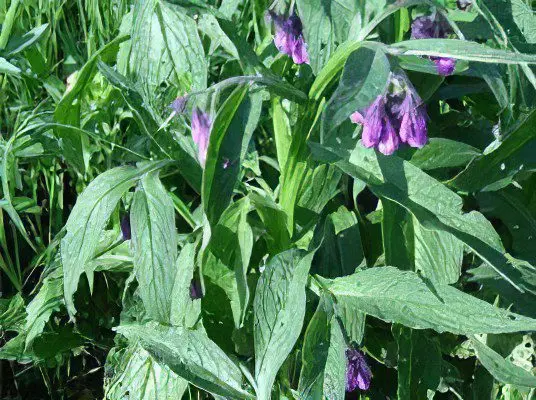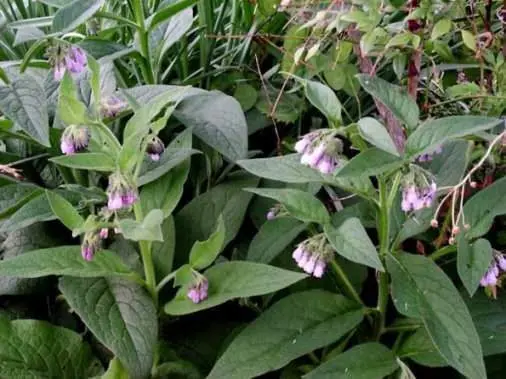Contents
Useful properties and recipes of comfrey officinalis
Botanical characteristics of comfrey
Comfrey is a perennial plant that grows up to 1 meter in height. The plant has a black rhizome with long roots, short and powerful. On branched and erect stems, covered with stiff hairs, there are rough leaves – large, alternate and lanceolate. The upper leaves are sessile, while the lower ones are on short petioles. Comfrey flowers are collected in drooping inflorescences-curls. Comfrey buds are small, reddish-purple, similar to bells, but there are also other colors.

The comfrey fruit is a large black nut containing one seed. Comfrey blooms throughout the summer. The fruits of the plant ripen from mid-July to early September. This medicinal plant is often found in Europe, Japan, Asia, and Africa. Comfrey can also be seen in New Zealand and North America. Comfrey is a moisture-loving plant, so it grows most often on the banks of rivers, in fields, next to swamps and streams.
Useful properties of comfrey
Comfrey contains tannins, resins, starch, choline, sugars, mucus and many other substances beneficial to the human body.
Comfrey has anti-inflammatory and antimicrobial effects. This plant is an excellent antispasmodic. Comfrey is used for bleeding as a means that stops the blood. Preparations are prepared from comfrey that help cure cough, soften and have an enveloping effect. Comfrey promotes the restoration of bone tissue.
In addition, the plant contains substances that affect the tone of the body, increasing its level. Comfrey is recommended for people with high blood pressure, it improves the digestion process.
Do not forget that comfrey contains poisonous substances that paralyze the nervous system.
The use of comfrey

Comfrey is used as a remedy in the treatment of osteochondrosis, bone tuberculosis, gout, arthritis, arthrosis and inflammation of the periosteum. Most often in folk medicine, comfrey is used in the form of baths, compresses, ointments and washes, which help in the treatment of bruises, scrofula, skin diseases, fractures, wounds and ulcers. Comfrey tincture on alcohol is also used as a compress for inflammatory processes.
In case of inflammation of the oral mucosa, diseases of the kidneys and lungs, comfrey infusion in milk is used. It is prepared as follows: we take 10 grams of comfrey roots and pour them with a glass of milk, put in the oven to evaporate for 6 hours. Take the finished infusion should be three times a day, 1 tablespoon.
Nosebleeds can be stopped by soaking a cotton ball in comfrey root juice.
Uterine swelling can be cured with comfrey tincture. This tincture is prepared quickly and easily. To prepare it, we take 10 grams of plant roots and fill them with 100 ml of alcohol. We leave for 14 days to infuse. Take the finished tincture before meals, 15 drops, which are previously diluted in 100 ml of water or boiling water.
Decoction for external use. Take 1 tablespoon of the roots of the plant and pour 100 ml of boiling water over it. Put the composition on fire for 10 minutes. After filtering, cool the decoction and make lotions, compresses, washings for skin inflammation, purulent wounds and fractures.
A decoction for stomach ulcers. To prepare it, we take 20 grams of comfrey root and 40 grams of the following herbs: St. John’s wort, chicory, plantain, knotweed, calendula (flowers) and horsetail. Mix everything and pour two cups of boiling water. Put the composition on fire for 10 minutes. After straining the finished broth, it is taken 100 ml three times a day before meals.
Comfrey ointment for external tumors. We prepare it like this: we take 1 tablespoon of the fresh roots of the plant and grind them to a gruel state. Add to this mass 1 tablespoon of pork fat. We put the composition in a water bath for half an hour. When the mass cools down a little, add 5 grams of camphor oil to it. Tumors are smeared with this ointment several times a day.
Comfrey poultices. To do this, you need to take fresh leaves of the plant and grind them. Crushed leaves are applied to sore joints, lower back. It is best to do this procedure at night, bandaging the finished poultice with a bandage.
Contraindications to the use of comfrey
Given the fact that the plant contains poisons, it should only be used with extreme caution. Pregnant women should never use preparations from this plant. Before using comfrey preparations, you should consult your doctor.









